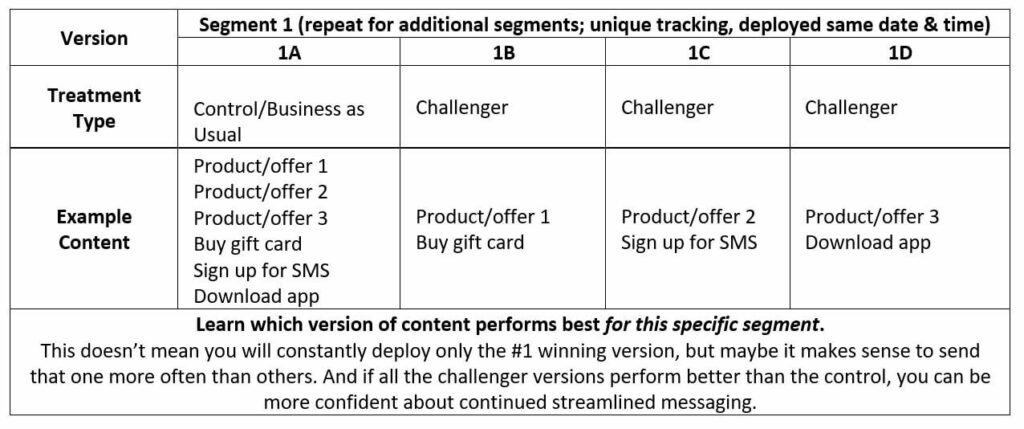Welcome to Part 2 of our behavioral science series! If you haven’t read Part 1 yet, check it out here for some helpful background information and context.
As promised, we are exploring three more behavioral science concepts within the context of marketing and customer experience (CX). We’ll cover inertia, choice architecture, and choice overload, including thought starters for testing each one. It is important to remember that the specific examples and test ideas are for inspiration and should be adjusted to your industry, channel(s), and circumstances.
1. Inertia
This concept is associated with the continued avoidance of taking action. It is a bigger factor for businesses in categories where consumers have recurring payments such as alarm systems, utilities, subscriptions, insurance, etc. In theory, a consumer who does nothing will continue to get the same service/product in perpetuity.
Consumer inertia can be a positive force for brands trying to retain customers. But it may be especially frustrating to marketers who want to generate upgrades from current customers or lure customers away from a competitor. Inertia is compounded when there is a real or perceived hassle to upgrade or switch brands (e.g., must send equipment back, set up new installation, or invest time and brainpower toward understanding an insurance or financial product).
It is not uncommon for consumers to stay with one brand after their 6-month promotional price ends even when they could save money by switching to a competitor. Doing nothing is the easy thing to do.
Newton’s first law of motion states that an object at rest stays at rest unless acted upon by an unbalanced force. When it comes to consumer inertia, businesses cannot rely on only one force (e.g., offers) because it might take a strong combination of forces to overcome friction and drive stubborn “bodies” to action.
Thought starters for testing the Inertia concept:
Marketing messages and call to actions can address many “forces,” but only if that copy is supported by the reality of the actual customer experience. For example, claiming there is no hassle to switch doesn’t work if the CX doesn’t prove it. Targeting is another important force. To know which forces to leverage, it is crucial to understand the reasons behind the inertia (by knowing your audience!) to identify what can and cannot be solved through copy and personalization. Getting the right copy in front of the right person to highlight the benefits they care about and address their specific barriers can certainly improve results, but it is not going to overcome major product issues, uncompelling offers, lack of trust, or terrible CX flow.
-
- Take advantage of outside forces already working in your favor to overcome friction. Do you know who is already “in motion” and more open to something new? – People who are going through major life changes. Marriage, divorce, moving homes, job change or loss, and pregnancy are all forces against inertia. Find people with relevant life changes and get your message in front of them.
- Enable current customers to easily opt in to a free upgrade for one month & require no further action to keep it going. Terms should be very transparent; you aren’t trying to trick them. You already have their personal and billing information so make the opt-in as few clicks as possible.
Employ customer analysis/research/modeling to identify targets with the most and least inertia. You can “slice” campaign results to look at each KPI by model decile, tenure as a customer, tenure on a CRM list, current product holdings, and whichever other data fields are available. For example, I worked with a brand whose long-tenured customers were great targets for certain products and terrible targets for others. They saved money and avoided bad CX by not sending irrelevant offers.
2. Choice Architecture
This concept describes the practice of presenting choices to decision makers in specific ways intended to influence their decisions. The choice architect determines such things as the number and order of choices, how to describe them, if products are bundled or à la carte, etc. A parent may rearrange items in the refrigerator to put healthy snacks at kids’ eye level while a grocer puts the cheap wine on shelves at foot level.
Thought starters for testing the choice architecture concept:
Choice architecture can be tested through copy, visuals, and the design of the purchase process (e.g., number of steps, what is packaged up front vs. suggested as an add-on later in the experience, etc.).
- Where it makes sense, consider an A/B test highlighting the positives of making a choice vs. the negatives of not making that choice.
- Purchase experience: Instead of a multi-step process asking the audience if they want to add on a widget (yes or no) and then following a yes with another decision (red/white/blue), ask which one of the widgets they would like to add (red/white/blue/none).
- In categories where the audience may not feel knowledgeable enough to make confident decisions, consider offering default options or indicating what is most popular or what would be recommended for different situations.
A marketer who isn’t deliberate about their choice architecture design could send their audience into the undesirable state of choice overload…
3. Choice Overload
This concept is exactly what it sounds like – too many choices available. Some people can get overwhelmed with too many options and might make a hasty decision and end up with a product they don’t like, or they might decide not to buy anything yet. They could move on to see what your competitor has to offer.
Thought starters for testing the choice overload concept:
Many people consider Patrick Lencioni’s following quote from his book Silos, Politics, and Turf Wars in the context of time management and task prioritization: “If everything is important, then nothing is.” But this observation is also valid in the context of advertising. Don’t treat your ad like it can cover as much material as an infomercial.
If you are tempted to feature your restaurant’s free dessert offer at the top of your email and add more modules for three other offers, plus promote kids’ meals and catering and ask users to sign up for SMS, take a step back and remember you should balance what you want to sell with doing what will generate a response or visit or purchase. That opens another door to achieve your goal.
- Test your current approach vs. more streamlined content. Ideally, you would have propensity models or historical learnings to identify the right products to feature more often for each lead/segment. If not, you can build learning opportunities into your test plan. Here’s an example with email (for illustrative purposes only; limited versions for simplicity):
- Be willing to test things that seem to defy logic. Maybe you’re in a situation where there are multiple levels or variations of your product or service (e.g., internet speeds, insurance products, membership tiers, add-on options, etc.). It might be easier for you to manage this situation on your website where people can filter and/or you can indicate what is recommended or most popular. But what do you do in channels that offer limited space and functionality and only a few seconds to grab attention? Avoid the temptation to show too many options or promote a top-tier product just because that is what you hope to sell. It is possible that featuring the lowest price may still generate more higher-price sales. It may sound counter-intuitive (when you are thinking more about sales goals than audience perspectives), but I’ve seen it happen numerous times. With one of my former clients, we always sold significantly more of their desired product by offering a different product that generated more responses. The audience was then upsold during the purchase process to the product that made more sense for them (and more dollars & cents for my client).
NEXT STEPS (These should sound familiar because they mirror Part 1.)
- Evaluate how consumers experience your brand through various interaction points across channels and phases of their customer journey.
- Document opportunities for testing these behavioral science concepts and prioritize which to do first, considering biggest potential impact as well as ease of execution.
- Test and adjust, as needed, and apply applicable learnings to other channels.
If you have questions, feedback, or would like to know how we can help you apply these and other concepts toward improving your CX and reaching sales goals, we’d be happy to talk to you anytime.
Want to read more blogs by Emily Martinez? Click here.


